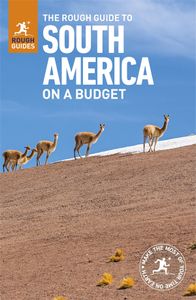Isla Fernandina
FERNANDINA, lying west of Isabela and dominated by the brooding shape of Volcán La Cumbre (1476m), is the youngest island in the archipelago, thought to be between 60,000 and 400,000 years old. It’s also one of the most volcanically active islands, erupting ten times in the twentieth century alone, and most recently in April 2009. La Cumbre is crested by a huge caldera, 6km wide and 900m deep, the floor of which exploded in 1968, sending it crashing down by 300m. Fernandina has so far escaped the introduced species that have so damaged other islands, leading to the claim that it’s the world’s largest pristine island; take care you’re not inadvertently transporting any organisms, such as seeds, on your clothes or the soles of your shoes.
Punta Espinosa, a spiky finger of lava at the northeastern tip of the island, is Fernandina’s only visitor site. It’s home to a sizeable colony of marine iguanas, their ashen bodies crammed head to foot on the black rocks. They lay eggs in pockets of sand and you’ll see Galápagos hawks in the trees nearby waiting to pounce on any stray hatchlings. This is one of the best islands for flightless cormorants, which stand at the water’s edge after a foray for food underwater, to dry out their useless wings. The Galápagos penguin can also be seen floating around the point, competing for fish with sea lions.
A trail here leads over rippled pahoehoe lava, studded with clumps of lava cacti, to a series of tide pools, a great place to spot crabs, octopuses and a range of shore birds, including whimbrels, herons and oystercatchers. A final trail heads eastwards to an imposing wall of aa lava, a jagged barrier to the slopes of Volcán La Cumbre.
Puerto Villamil and around
PUERTO VILLAMIL, sitting under the cloud-draped slopes of the huge Sierra Negra volcano, was founded at the beginning of the nineteenth century and named after the general who annexed the islands for Ecuador in 1832. Now home to most of the Isabela’s 2200 settlers, the quiet port isn’t well developed for tourism, and visitors are infrequent enough to stick out. Just a small town of sandy roads and simple houses with fences of woven branches and cactus, fronted by a beautiful palm-fringed beach, it is nevertheless one of the most pleasant off-the-beaten-track places to stay on the islands, boasting several good attractions nearby that can be seen without guides.
A small dusty square, fronted by the municipio and a simple church, fixes the centre of town a block back from the waterfront, dock and Capitanía. Heading north of the square takes you towards the airport and highlands. There’s not much going on in town, but plenty to see nearby. To the east is a path to Concha de Perla, a quiet and sheltered little bay with reasonable snorkelling. To the west, Avenida Antonio Gil heads west and passes small, secluded lagoons (pozas) – where you can spot waders, shore birds and sometimes flamingos – before a signposted track branches off north to the Giant Tortoise Breeding Center, about twenty minutes from the town centre. Work is ongoing here to breed the island’s five unique tortoise subspecies, each based around the five largest volcanoes. On show are the rearing pens for the tiny hatchlings, and corrals for adult tortoises taken from the wild, including Cerro Azul tortoises rescued from the volcano when it erupted in 1998 and others saved from a serious forest fire on Sierra Negra in 1994.
The westward road along the coast (ignoring the turn-off to the tortoise centre) continues past several peaceful beaches, including the Playa de Amor, where there are some scenic trails perfect for local wildlife spotting. After about two hours’ walk, you’ll come to El Muro de las Lágrimas (The Wall of Tears), a testament to the suffering of three hundred prisoners who toiled here in the 1940s and 1950s; they had to build their own prison using sharp-edged lava boulders. Many died making the wall, which was some 190m long, 9m high and 6m wide at the base when the prison colony was abandoned after a revolt in 1959.
The best place to see marine life in the area is at Las Tintoreras (also known as Las Islas de los Tiburones), a handful of ragged black-lava grottoes poking out of the sea, a short boat ride from the port ($15–20). From the natural dock a trail leads past scuttling marine iguanas up to a lagoon and a narrow channel, where a “viewing gallery” allows you to see the sleek shapes of white-tipped reef sharks cruising back and forth. You can swim and snorkel in the lagoon – though don’t swim in the channel itself, as it’s not big enough for both you and the sharks – or back at the landing site. You may see rays and marine turtles here or in the gin-clear waters at Cabo Rosa, about an hour’s ride away by boat from the port (local tour agencies and hotels can arrange this), where semi-submerged lava tunnels have created a striking, otherworldly landscape. The water is shallow here, so the approach is sometimes difficult in the dry season.




















